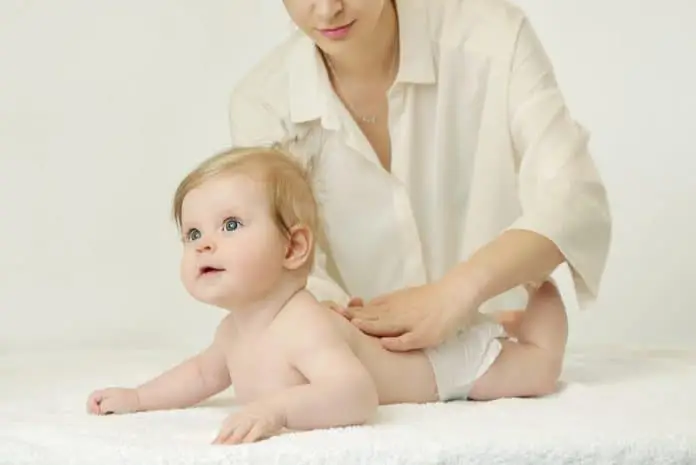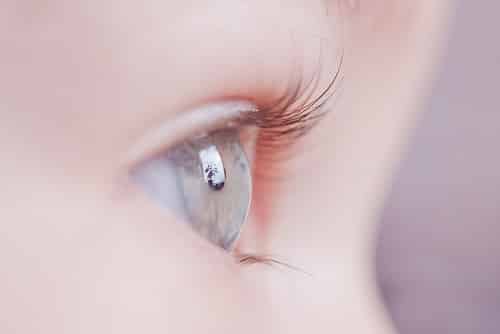Baby massage is the best solution for sleep, gas, and constipation problems. By three months old, the part of your baby’s brain involved in detecting touch is more active.
Babies that are massaged are more alert and active when they’re awake; they fall asleep better and gain more weight. They also have a better temperament, be more sociable, and are less likely to cry.
The benefits of baby massage
Parents who massage their infants do so as a priority to share with them a moment of tenderness and complicity. Enabling them to establish emotional communication with their child through touch is the primary goal.
Love, security, appeasement… Emotions don’t always need named beings; they can also be transmitted through the skin and many of the sensations that go through the message.
It puts all the sensors in our body into the pipeline, including our hormones. Touch also promotes the stimulation of oxytocin, which is different than the attachment hormone.
But if they carry the messages out to provide well-being to their baby, they have other benefits. It also allows the child to become aware of his own body, both by touching it and also by speaking.
That’s why moms and dads are invited to talk to their babies during the message: ” I’m taking your little foot now, and I’m going back to your leg.”
Like most massages for adults, massage for babies can help relieve pain or stress and has therapeutic goals.
For example, some gestures may help a baby with colic or a child with a toothache.
The more you appreciate the importance of touch, the greater it seems to make it to massage your baby. Infants can be soothed with infant massage.
Training in these specific techniques so not to harm your baby is imperative. Ask your pediatrician for information on training opportunities.
In general, these massage specialists use clockwise circles, starting at the top of the baby’s limbs and working their way downward. Too much pressure can be harmful to your infant. Avoid the head area.
Use powder or cream;
Note: Use powder or cream; it proves that it is safe for infants less than Six months of age to be massaged more.
There are many benefits: massage can help your baby’s circulatory, respiratory, and digestive systems, and encourage growth. It is also good for stimulating muscles.
Some believe between three and four months, but I think you can start right away as long as your baby is healthy and you choose a time when he is alert and ready for some stimulation. Don’t message just before feeding or too soon after.
Make sure you’ve got lots of time and concentrate on what you’re doing. For example, try to massage while you watch television. And don’t break the spell by making sudden movements.
You need baby oil, a warm room, and a comfortable space for your baby. Make sure she is not cold, turn the lights down, and wash and warm your hands before you begin.
1-Contribute to the well-being of infants of depressed mothers.
In a clinical trial, 40 babies between 1 and 3 months old were given either 15-minute massages or sessions to help them calm down twice a week for 6 weeks.
The children of the massage group gained more weight and showed a calmer temperament and better emotional and social provision.
They were also less stressed, cried less, and fell asleep more easily.
2-Improve mother-child interaction in mothers with postpartum depression.
In a 2001 trial, 25 mothers with postpartum depression were separated into 2 groups.
The first people to take part went to group baby massage classes for an hour a week for five weeks. They also got emotional support and useful tips.
The second received only support and advice. Only the massage group showed improvements in how the mother and child interacted with each other and how the mother felt.
But a quarter of the people in the study dropped out along the way, which suggests that this method might not be easy for most people to use.
3-Foster sleep in newborns
During a trial, 21 infants aged 6 weeks were randomly assigned to a group receiving a daily half-hour massage prior to bedtime or to a control group (simple touch of the mother).
The results show that massage therapy can help adjust the daily sleep-wake cycles, which makes it easier to fall asleep at night.
Also, after measuring metabolites in the urine of babies, the authors came to the conclusion that massage helps make more of the sleep hormone melatonin.
4-Improving the growth of children born prematurely
Various positive effects of massage on premature newborns are reported in the scientific literature.
For example, it could influence weight gain, reduce stress, and promote, among other things, developmental tasks, brain development, and visual function, bone formation when combined with physical activity, reduce hospitalization time, and reduce pain in some care procedures.
However, most of these findings are based on clinical trials with small sample sizes and methodological gaps.
That is why it is not possible at the moment to make a clear decision on its effectiveness. Also, we need to be careful because the child’s fragility means that we need to act with great care.
How to do a baby massage?
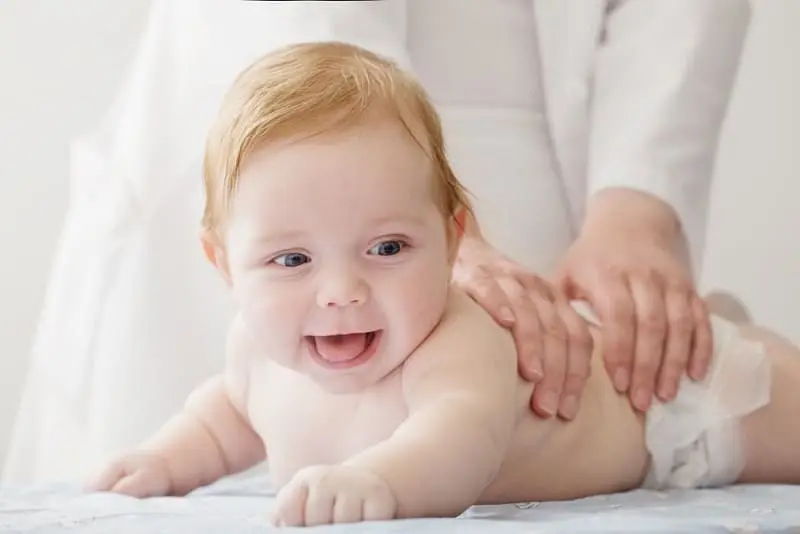
When you massage your baby, you also get to know him. You will notice, for example, that he likes to mass his legs, but he gets agitated when we mass his arms.
You must adapt to your needs so that the timing of the message is pleasant. Here is what you can do if you want to massage your baby. Start with a few minutes of massage.
Be careful and adapt to your baby’s needs and reactions. Stop if he turns his head, stiffens, admits, or seems upset.
If he reacts well and you feel comfortable, you can continue. Massage your baby’s arms, legs, and back. As they use him to get touched in these places, this message should not stress him.
Then add the massage of the face, torso, and neck. To begin, you can: – wrap your hand around its ankles or wrists and then make small circles with your thumb and index fingers;
Wrap your hand around your wrist (C-shaped) and drag it to your shoulder. Sing or talk to your child while you massage it. Listen to their “answer”. Do you massage your child?
When can you massage your baby?
A newborn may be massaged from the first days following birth, from the time parents feel ready to do so.
The first time the message lasts only a few minutes and then grows as the child gets used to it. The most important thing is to find the right time for the child, but also for the parent.
Attention, babies are not always available for a message.
It is only with time and experience that we learn to recognize the good times. But parents also need to learn to isolate the time they are available.
Massage is a moment of relaxation. It must not be unnecessarily packed into an overloaded schedule, otherwise, it loses all its positive character.
Knowing that her baby is available for massages is not obvious.
Each child is unique; the signals are different for each. However, as parents learn to know their children,
they can identify the most suitable moments for a massage, for example, those where the child is awake and in good humor. “
In order to share a moment of well-being with her baby, ” it is really necessary to be relaxed.”
Before massaging her baby, it is sometimes beneficial to take a few minutes to relax his own tensions, ask himself questions, and to refocus himself. It is only by feeling this state of relaxation that we can then pass it on to our baby. “
How to do a baby massage perfectly?
Massaging her baby is not a technical gesture, but instinctive. ” There are baby massage workshops,” but the goal is not to come up with a done method.
For parents, it is above all, above all, to gain the confidence and the feeling of being able to reproduce, instinctively, the movements when we are alone.
” You can have the desire to massage her baby, but do not dare to start.” Some apprehension is legitimate when faced with such a small and fragile (seemingly) object.
Intuitively, we are able to know what we can do or not, but for some of us, it is important that the actions be validated, and backed by an expert.
Thanks to the workshops, parents who want to can learn a few moves, but more importantly, they can make sure they know how to massage their kids.
” When massage becomes a habit, it starts quickly as a ritual, a tenderness between the parent and the child.”
We often start the massage session by talking to the baby, telling him what we’re going to do, then preparing the accessories (the oils, the cover…), and removing his rings, and bracelets.
As many signs as the child and which allow him to put himself on condition. ” And how to know that a baby likes massages?
It is generally enough to observe it during this preparation period. If they show enthusiasm, you make them smile, and gasp. It’s his way of telling you that what he’s waiting for is something he enjoys.Quite simply, “
Tips to Massage Your Baby
Here are some tips that will allow your child to enjoy massage even more. Choose a time during which your child is awake and relaxed. It could be before sleep, after the bath, or before drinking, for example.
Avoid massaging the baby when asleep, weeps or is very agitated. If your baby is cold, cover it with a soft cover and just get the member you are massaging.
Since your baby is wearing only a diaper during the massage, make sure the room is warm enough to make it cold. The chosen room should also be calm with soft lighting. Sleep on the floor, or in your bed.
If you prefer to stand up, drop your child on the table. Use vegetable oil (e.g., canola oil, olive oil, grape seed oil) to massage your child. You can also use a moisturizing cream.
However, avoid massage oils and petroleum products (e.g., vaseline). Do not wear jewelry, as it may irritate your child’s skin.
If your baby likes to be massaged, you can add a message to his daily routine. For example, you can dedicate 15 minutes a day to their message at a time of the day when your child is very quiet.
The 5 Golden Rules of a Successful Baby Massage
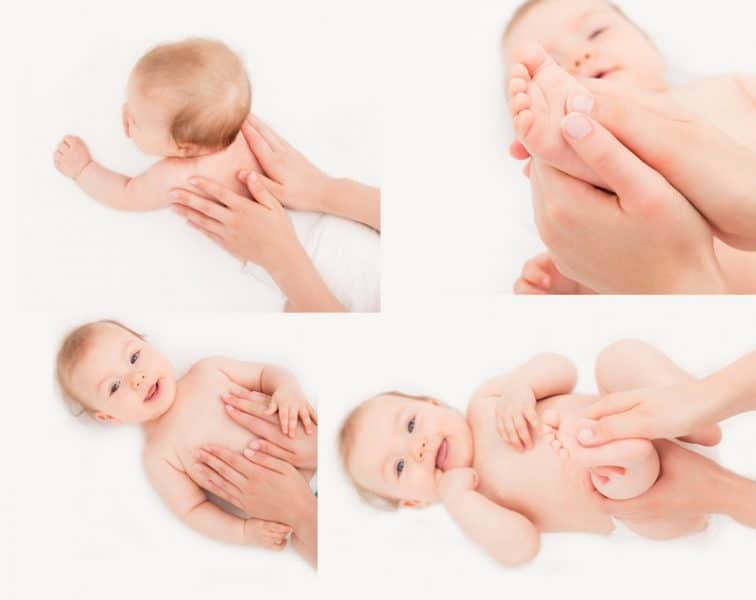
Choosing the right time:
For him as well as for his child, massage must remain a moment of sharing and well-being. It must therefore not be forced or carried out reluctantly, in haste and stress.
– Be properly installed:
You can’t relax in an uncomfortable position. Whether you choose to massage your baby while standing in front of the table, on your knees on the ground, or sitting on his bed, the essential thing is to feel comfortable.
– Healing the atmosphere:
Even if it is possible to massage a baby through his clothes, it is generally not possible, hence the importance of the room being heated. The light can be sieved.
-Avoid outside stimuli:
Noise (from television, and the street…) prevents deconstruction, whereas soft music favors it. Toys can also be remote controlled so that the child can stay focused on their sensations.
Focus on his actions:
Skin is also a good way to get in physical contact with your child.
If massage is not necessarily technical, it must be done carefully. The baby will be more confident and reassured if the gestures are firm and safe. In addition, it is preferable to always operate symmetrically (one leg and then one foot, one foot and then another…) to help the child become aware of their body and members.
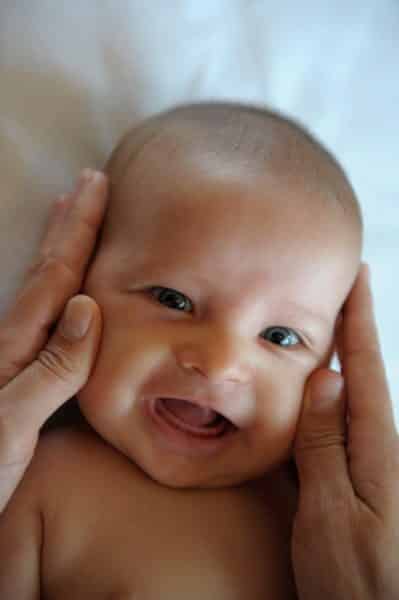
Infant likes massages
Some children don’t like massage the first time. If your baby cries when you start massaging, try: Some babies do not like to be massaged, regardless of the talents of the person who is massaging. To caress it slowly, Talk to him about a very sweet tone to sing in to help him relax.
If, however, he remains disturbed, try again later. This may be simply because it is a new experience for him.
If your baby is tired, hungry, or, on the contrary, has a full stomach, he may not want to be massaged. Other babies are more sensitive to touch and do not support massages.
If this is the case with your child, you can wait a few weeks before trying again. Some babies also prefer that their parents simply put their hands on them.
The essential environment for a good baby massage
A baby message can be delivered in a warm (around 26 degrees Celsius) and quiet environment. Made before naptime or bedtime, it can release excitement and promote sleep. Getting out of the bath is also a good time.
The stance should be comfortable for the parent and the baby. To do this, you have several options:
Sit on the floor or on a bed with a straight and flexible back. Place the baby facing you, on a pillow or coverage, as close as possible to you. This will reassure him.
You can also lie with your legs stretched out, and your back straight, and place your baby in the hollow between your legs, on a blanket or a pillow. The baby may also be lying on the changing table.
Before you start, remember to remove your jewelry, wash your hands, and above all, relax: it is essential to ensure a beneficial massage. Rub your hands with oil or milk and rub them for a few moments to warm them.
The baby’s legs massages
Massage each leg with the inside of the hand between the thumb and forefinger, thumb down, by making successive two hands from the groin to the ankle. This releases tension in the legs and promotes the circulation of blood to the feet.
Then lift one leg toward you, being careful not to raise the baby basin, and surround her with both hands, as if to form a bracelet.
Make a slight movement of “screwing-unscrewing”, to relax the entire thickness of the muscle.
You can also roll the leg between your hands, from thigh to ankle.
Massage Your Baby’s Arms & Hands
Hold the wrist with one hand and with the other, massage the arm from the shoulder to the wrist, with the flat of the palm, the inside of the hands facing you. Stabilize the shoulder in order not to raise the baby.
As for the legs, then make a slight movement of “screwing-unscrewing”, both hands still close to not twist the elbow.
As for the feet, massage the fingers and then the top of the hand, and finally the wrist by making small circles.
The baby’s feet massage
Massaging the feet is beneficial for the body because they are extremely rich in nerve endings. Drag an inch after another on the sole of the foot, from the heel to the toes, then massage each toe.
Gently massage the heel and the sole of the foot with both thumbs. Don’t forget the tops of the feet and ankles. After having massaged both legs and feet, massage the buttocks with small circular movements.
Baby massage on the tummy
Hands a moment on the baby’s belly, and then massage, bringing to you a hand after another. Then drag your hands flat on each side of the belly. With the flat of your fingers, massage in the sense of clockwise in a circle.
Belly massage tones the digestive system, helping to regulate transit and relieve gas and constipation.
Baby Face Massages
With the flat of the fingers, smooth the front, from the middle to the temples. Then massage the eyebrows, always towards the temples.
With your thumbs, go up on each side of the nose, then scroll diagonally to the cheeks. This gesture helps declutter the nose and relaxes the muscles of the cheeks.
Then, with the tip thumbs, gently stretch the upper lip and the lower lip, as with a smile. Finally, relax the jaw, drawing small circles with the tips of the fingers.
Massage for the baby’s back
Massage of the baby’s back is often the most relaxing massage for the baby. Put it down on your thighs, or on the changing table, then put your hands across the top of the back.
Go and come perpendicular to the axis of the back, one hand after another, to the buttocks, then go up to the shoulders.
One hand on the baby’s bottom, then slide the other hand from the shoulders to the buttocks.
Finally, draw small circles with the tip of your fingers on the entire surface of the back, and then, with the fingers slightly apart, “paint” the back of the shoulders to the buttocks.
You can complete the exercises smoothly by massaging the baby in order to stretch the muscles of the baby. However, be sure to choose exercises appropriate to his age and his motor skills.
Don’t forget that during the massage, you can talk to your baby, or even sing. This will surely reassure him. If you want to deepen these massage techniques, they’re also available in some cities in the workshops of massage. Feel free to ask.
The history of baby massage
baby massage is inspired by Indian massage, Swedish massage, reflexology, and yoga. For millennia, baby massage has been part of the everyday life of many civilizations.
This ancestral practice, transmitted from mother to daughter until today, gradually began to grow in our culture, thanks to the American Vimala Schneider McClure, who introduced it to the US in the early 1980s.
She was introduced to baby massage when she worked in Indian orphanages in 1973.
By applying her knowledge of her own children, she was surprised by the results. So, she decided to study how babies grow and what happens to them when they are massaged.
During discovery and experimentation, she created her own method by integrating movements borrowed from various massage techniques.
In 1977, she wrote a book on baby massage and began teaching it. In 1981, she founded the International Association of Infant Massage (IAIM) with a group of 7 instructors to transmit her practice.
In 1986, the association was officially recognized in the United States as a non–profit organization. IAIM is the only international organization setting up baby massage training.
It has a number of national sections whose goals are to promote and teach massage and to help, improve, and be with parents who prefer to talk to their babies in a different way. Since 1992, the head office has been transferred to Sweden.

